Norbert Wu reviews fins
Page 1: Introduction. Page 2: Open heel fins. Page 3: Closed heel fins.
Open-Heel Fins:
1. Sherwood open-heel Elite fins:
1 lb 8oz; $99 at scuba.com; +3 speed rating; negatively buoyant; standard fit. I was very impressed with these fins. They are the lightest open-heel fins that I have seen. They were super easy to get used to and were the fastest yet in the water. The foot pocket is a bit hard and narrow. With booties, I started getting foot cramps both times that I tested the fins. My fins came with rubber straps that had nice quick release buckles on them, but were not adjustable. They were a little tight when I wore booties, but when I wore these fins with only Henderson Microprene fin socks, these fins felt pretty good (the hard foot pocket was still hard).
I later used these fins with thicker neoprene socks and with EZ spring straps from Leisurepro. I was pretty happy with this combination. These fins are fast, fairly stiff, but I seem to be able to manoeuvre in them. I like them a lot and may use them for tropical AND fast snorkelling (eg whale sharks, whales) with thicker fin socks (not booties).
The Sherwood Elite fins are now my first choice for snorkelling and diving in tropical waters, with thicker wetsuit socks or booties. I look forward to trying a pair of these in size Large, to see how they work with my drysuit. I like the fact that these fins come with a standard post so I could mount EZ spring straps on them.
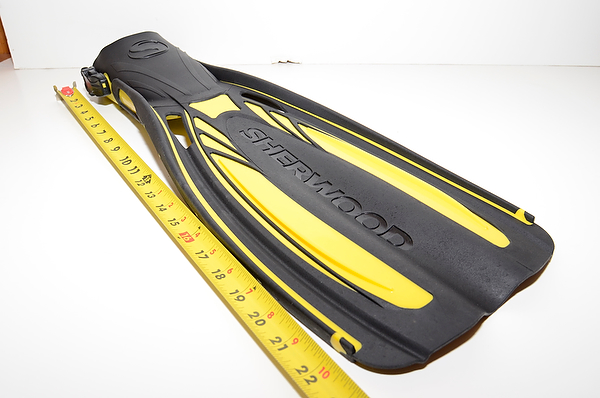
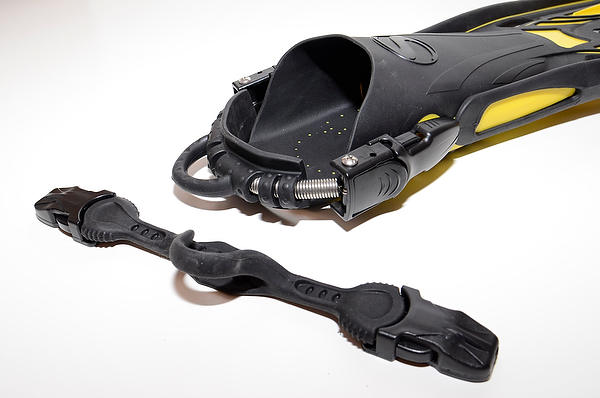
ScubaPro Twin Jet open-heel Split Fins in black:
2 lb 0 oz; $169; -1 speed rating (slower than baseline); standard fit. I’ve had a pair of these fins in gray, size Large, for several years. I use them with my drysuit; they are extremely comfortable. They let me swim around in my drysuit without creating pains in my knees. My feeling prior to testing these is that they were comfortable but a bit slow, and my testing bears this out. I tested the Medium size, which were a bit large for my foot in a bootie. Swimming with these is slow but very pleasant. I felt like I was hardly using any effort, but I was still tired after swimming 400 yards. One strange thing is that my thighs cramped up almost as soon as I started moving around in these fins, something which did not happen with any other fins so far. Seems to give enough power and is very manoeuvrable. Very comfortable to put on and wear. The rubber strap with the quick-snap buckle system has worked well for me for years. These fins came with traditional adjustable rubber straps, but I can see that there are stainless steel straps that fit the buckles on these Twin Jets.
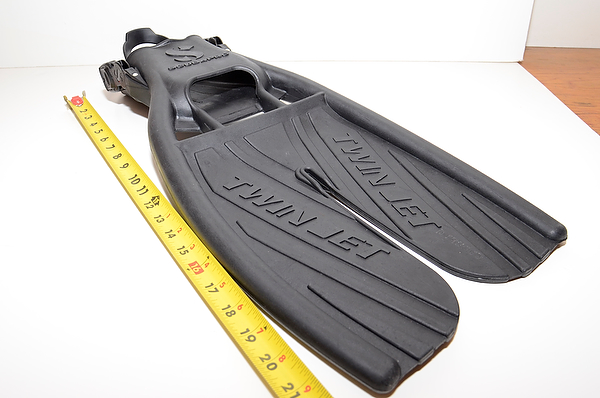
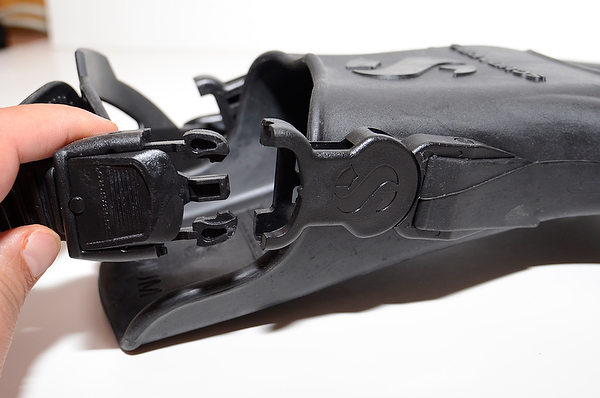
These fins were black in color. Back in 2001, Sergio Angelini, a longtime star engineer, designer, and executive in the diving industry (who has helped me a great deal over the years – thanks Sergio!) gave me some Twin Jet fins, which were brand new at the time. Here’s what he wrote, “I am sending you out two sets of fins. There is a soft version (blue or grey…) and a stiff version (black). Typically, people not used to the split fin technology will immediately love the black, and maybe be perplexed by the soft version. But once you get used to them, the soft ones are better: faster, more efficient, more comfortable. Some people use the black for cold water diving with lots of gear that causes drag, and the soft ones in warm water. I myself use the soft ones, and I dive with drysuit, pony bottle strapped to the front left, 3 big lights strapped to the front right, and we have very big currents …. Both pairs will be size L, which will definitely fit over your drysuit.”
“Of the three colors, the Black Fins are the most Rigid and offer a more traditional fin experience. The Black Fins are slightly negatively buoyant. The Blue Fins model is made of a more buoyant and flexible compound than the black models. This allows you to achieve the most Bang-for-your-Kicking Buck. These fins are slightly positively buoyant. The Yellow Fin option is made of a compound similar to the Blue model, but offers the greatest opportunity for you to be seen underwater. The Yellow fins are slightly positively buoyant.”
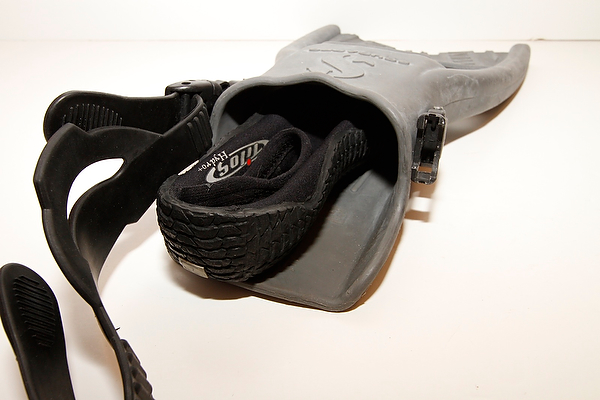
I checked with Scubapro. They no longer make the grey version, but still make the yellow and blue colors. These fins are indeed more flexible, if the above comments still apply. I do a lot of shark diving trips, where the leaders of the trips only allow all-black or all-dark diving gear – so using fins that are yellow or have bright colors is not a good option. On the other hand, long, bright yellow fins make a good signalling device when you are in the middle of the open ocean (say, at Cocos Island) and drifting away from the dive tender or mother ship.
Scubapro Twin Jet Max open-heel Split Fins:
2 lb 8 oz per fin; $189; -0.5 speed rating (slower than baseline); standard fit. These are a stiffer version of the Twin Jet series. They came in a nice mesh bag, with super-comfortable stainless steel straps. The size Mediums were just a bit large for my feet with booties; they fit my drysuit booties well. A pair of these fins will weigh 5 pounds, which is a fair amount of weight for fins (in comparison, a pair of Sherwood Elite fins, size Small, would weigh only 3 pounds).
Swimming with these fins felt effortless, but fairly slow, coming in at 10 seconds slower than my standard Pod fins. Given the weight difference and my sense that these stiffer split fins won’t manoeuvre as well, I’d choose the older Twin Jet fins over these for drysuit diving.
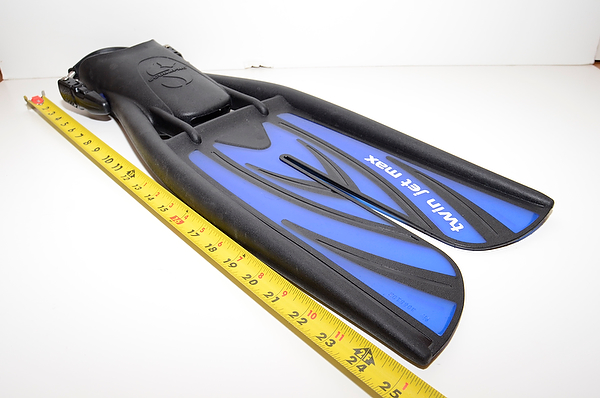

Atomic open-heel split fins:
2 lb 7 oz per fin; $209; +1 speed rating; positively buoyant; standard fit. Upon first seeing these fins, I expected them to be slow. I was wrong. They are pretty heavy out of the water (a pair of fins will weigh almost 5 pounds); but once in the water, they are comfortable and pretty fast. Here are my notes after using them a couple of times: “I really liked these after trying them. Pretty fast, powerful, and manoeuvrable.”
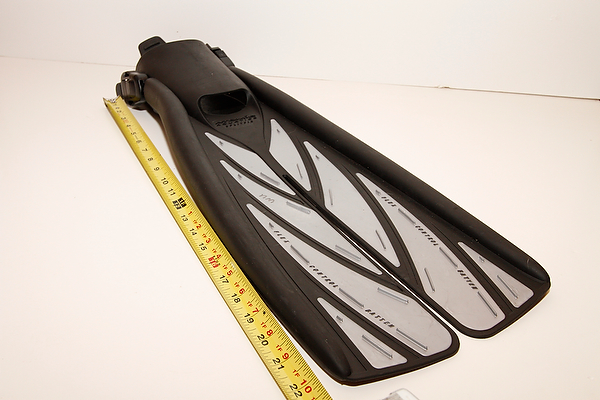

Page 1: Introduction. Page 2: Open heel fins. Page 3: Closed heel fins.